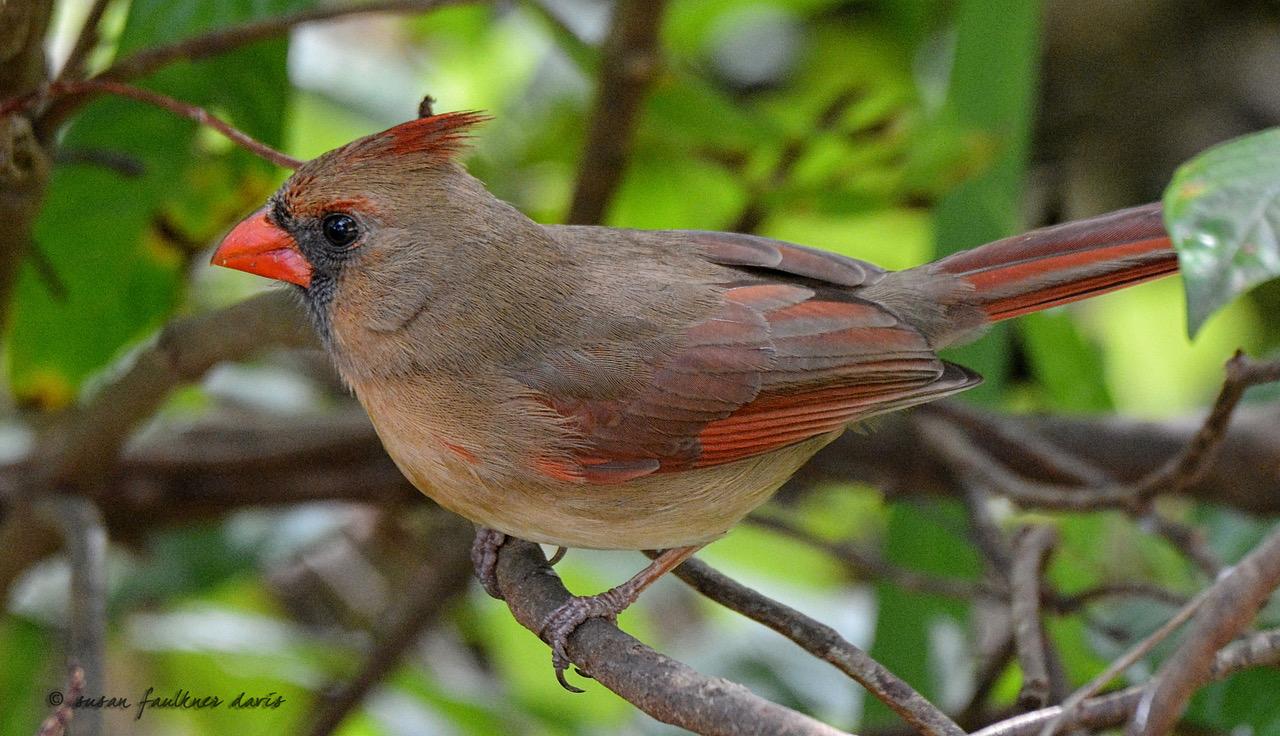
April Bird of the Month is the Northern Cardinal, and here is the article in the upcoming April 2019 Kite written by Clive and Celecia Pinnock.
April Bird of the Month – Northern Cardinal
Northern Cardinal (Cardinalis cardinalis)
by Clive and Celecia Pinnock
The vibrant red color of the male cardinal with its red crest and accented black face has made this species one of the most recognized in eastern North America, from as far north as eastern Canada to southern Florida. Due to its popularity, the Northern Cardinal is the official state bird of no fewer than seven states in the eastern United States. The mostly brown female, although not as brightly colored as the well-recognized male, also sports a sharp crest and warm red accents. Because cardinals seldom migrate, our neighbors in the northern states are able to enjoy the brilliant splashes of color the red male and his attractive mate add to otherwise drab or snow-covered landscapes.
Northern Cardinals are typically observed in dense thickets, shrubby areas such as forest edges, overgrown fields, hedgerows, well-planted backyards, marshy thickets and ornamental landscaping. They nest in dense foliage, and the male looks for conspicuous perches from which to sing while establishing his territory and advertising his availability to a receptive female. Although pairs may stay together for successive years, about 20% of birds will seek other mates in successive seasons.
With the spread of towns and suburbs across eastern North America, cardinals, once primarily a southern species, have been able to expand their ranges further north. Suburban gardens, parks, orchards and similar habitats have been instrumental in attracting and keeping cardinals in these new areas, providing ample food resources and nesting sites.
Cardinals eat mainly seeds and fruit, supplementing these with insects, which are predominantly fed to the young during the spring and summer nesting seasons. Common fruits and seeds include hackberry, wild grape, mulberry, blackberry, grasses and sedges. With the increasing popularity of using birdfeeders to attract birds to backyards, nature centers, school yard gardens, etc., birdseed mixtures, especially those including black oil sunflower seeds, have worked well to attract cardinals and other seed eaters (blue jays, woodpeckers and squirrels). The insect diet is primarily made up of beetles, flies, ants, caterpillars, and grasshoppers. Meat protein also comes in the form of spiders and centipedes.
Nests are usually well hidden in dense shrubbery, vine–tangled thickets and the like, anywhere from 1 to 15 feet above the ground. The nest is made by the female, using material supplied by the male, who spends most of his time guarding the territory. Three to five eggs are laid and incubation by the female lasts for 12 to 13 days. Both parents care for the young, which generally fledge 9 to 11 days after hatching. The male may continue caring for the young for a short period after fledging, while the female begins a second nest. Two or three broods are sometimes raised in a season, especially in southern states, where temperatures are more accommodating.
Please check out the picture by Susan Faulkner Davis in the upcoming April KITE cover and to see the slide show of the entire virtual gallery this month, along with photographer etc — click on BOM SLIDE SHOW below the pictures displayed here:
[flickr_set id=”72157677249464697″ max_num_photos=”100″]


Comments are closed